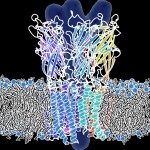Lien vers Pubmed [PMID] – 18987633
Lien vers HAL – Cliquez ici
Lien DOI – 10.1038/nature07462
Nature 2009 Jan;457(7225):111-4
Pentameric ligand-gated ion channels from the Cys-loop family mediate fast chemo-electrical transduction, but the mechanisms of ion permeation and gating of these membrane proteins remain elusive. Here we present the X-ray structure at 2.9 A resolution of the bacterial Gloeobacter violaceus pentameric ligand-gated ion channel homologue (GLIC) at pH 4.6 in an apparently open conformation. This cationic channel is known to be permanently activated by protons. The structure is arranged as a funnel-shaped transmembrane pore widely open on the outer side and lined by hydrophobic residues. On the inner side, a 5 A constriction matches with rings of hydrophilic residues that are likely to contribute to the ionic selectivity. Structural comparison with ELIC, a bacterial homologue from Erwinia chrysanthemi solved in a presumed closed conformation, shows a wider pore where the narrow hydrophobic constriction found in ELIC is removed. Comparative analysis of GLIC and ELIC reveals, in concert, a rotation of each extracellular beta-sandwich domain as a rigid body, interface rearrangements, and a reorganization of the transmembrane domain, involving a tilt of the M2 and M3 alpha-helices away from the pore axis. These data are consistent with a model of pore opening based on both quaternary twist and tertiary deformation.


